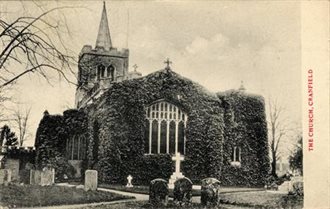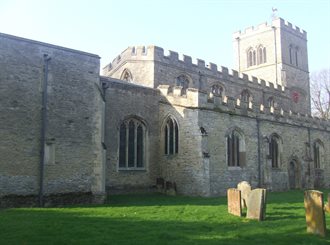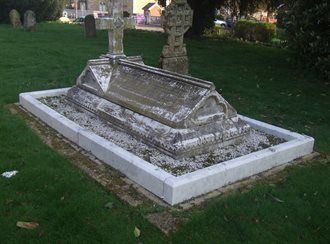Parish Church of St. Peter and St. Paul
This page was written by Sally Williams
Note: A comprehensive history and description of the Parish Church of St. Peter and St. Paul has been published by Dr Marjorie Cotton. Some extracts from the parish church guide have been summarised for use in this document. The Parish Church Guide can be purchased at the church.

Cranfield Church c.1910 [Z1130/34/12]
Land in Cranfield was gifted to Ramsey Abbey under Abbot Aednoth (993 – 1008), the first abbot at Ramsey, by Ailwyn Niger on his death in 998. After 16 years as Abbot, Aednoth was elected Bishop of Dorchester and died in 1016 on the field of battle with Edmund Ironside in his campaigns against the Danes. Aednoth’s successor at Ramsey, Abbott Wulsi (1008 – 1016) also died in the same battle at Essenden, Essex.
A church existed in Cranfield in the 12th century and it has been suggested that there may have been a Saxon church on this site, probably of wood with a thatched roof.
It was under the eleventh Abbot, Walter (1133 – 1161), that the present stone built church started to take shape. However, as Cranfield village grew, the church was enlarged in the mid-13th century. The current building includes a reused round headed doorway of the late 12th century, the “ Norman Door”, which has now been set into the north aisle wall to the left of the tower. The original bell tower was also built at this time.
It has been suggested that the increased prosperity in the village may have been due in part to the reputation of the “Holy Well” located to the south of Holywell School and close to the footpath which connects Rectory Lane to Bedford Road. The water from this well, which is rich in iron, was reputed to be good for treating people with sore eyes and would have attracted people to the village no doubt presenting commercial opportunities for the locals.
Further alterations and additions were carried out in the 15th century; these included several windows, most of the roofs, the new clerestory and the heightening of the tower. It was dedicated to St. Peter and St. Paul and remained in the Abbey's hands throughout the medieval period. The Abbey had the right to appoint the rector.
In 1551, Church Commissioners were directed by King Edward VI to make an inventory of church ornaments with a view to valuables being appropriated by the Crown. In Cranfield 2 brass candlesticks and 2 censers (for burning incense) were found and subsequently removed by Nicholas Luke, baron of the exchequer. The weight of the plate was 2867 oz. and this was melted down at the Tower of London.
Not all clergy showed high standards of behaviour: in 1602, the Rector of Cranfield struck Hugh Bradley in church and “did spurn his hat up and down the church and miscalled him”.
Throughout the mediaeval period and up until the 1840 Enclosure Act, The Rector was entitled to receive tithes from the parishioners amounting to one animal in ten or one tenth of the produce grown every year. After the Act, landowners had to give one tenth of their land to the Rector and he also gained much of the common land. This increased his holding from 84 acres to 693 acres for which he could take the rent.

Parish Church of St Peter and Paul, Court Road, north aspect. Photograph by Sally Williams
The most famous incumbent at the church of St. Peter and St. Paul is undoubtedly the Rev George Gardner Harter who came to Cranfield from Lancashire in 1845. He was the son of an eminent Manchester merchant. The latter presented the church with the stained glass East Window.
The Rev Harter oversaw significant restoration of the church and the graveyard during 1865-6. He also gifted the lower school (now Cranfield Academy) and the village Hall which was given in memory of his son James in 1911. He was also responsible for the construction of Cranfield Court, a palatial property in Wood End.

Interior of Cranfield Church, c.1905 [Z1130/34/16]
The original Rectory was a large house situated at the end of the drive. To the left of the drive was a moat which had a wooden bridge across, leading to the tradesmen’s entrance, the tennis courts and croquet lawns. On the right-hand side was the gardener’s cottage and outbuildings, a walled garden and a spinney. In front of the house was a large lawn with weeping willows where the Church Fete, Sunday School Teas and other events were held. The current development of East Hills was built in 1966 on the site.
The curate would have lived in The Walk House, where Walk House Close now stands. It was demolished in 1965.
Towards the end of the 19th century, victims of an outbreak of smallpox were buried in a plot of land to the south of the bell tower just beyond the lime trees. This was known as the plague pit. At the instigation of the Rev Harter, the area was railed off to keep persons and livestock away from the potentially contaminated area. The rails were removed during World War II.
The graveyard contains some interesting monuments: One is the grave of Captain William Swabey of the Royal Horse Artillery was a veteran of many campaigns including the Battle of Waterloo in 1815. Capt Swabey served as a Justice of the Peace and Deputy Lieutenant of the County.

Grave of Captain Swabey in Cranfield Churchyard. Photograph by Sally Williams
The graveyard also contains the grave of Lydia Hallworth who claimed to be the niece of George Washington, the first US President. Recent research now show this to be untrue and a story fabricated by her.
A library for Cranfield
A collection of books was made by the church and kept in Cranfield as a library at some time in the late 17th, early 18th Century.